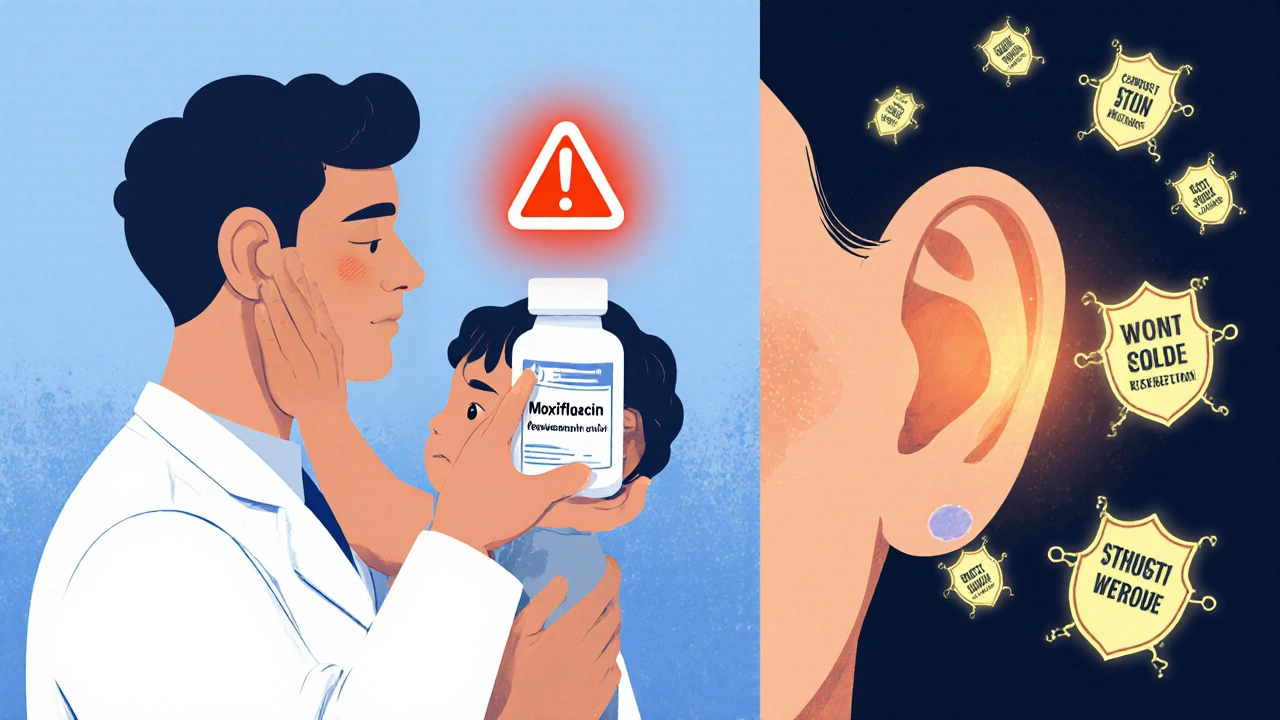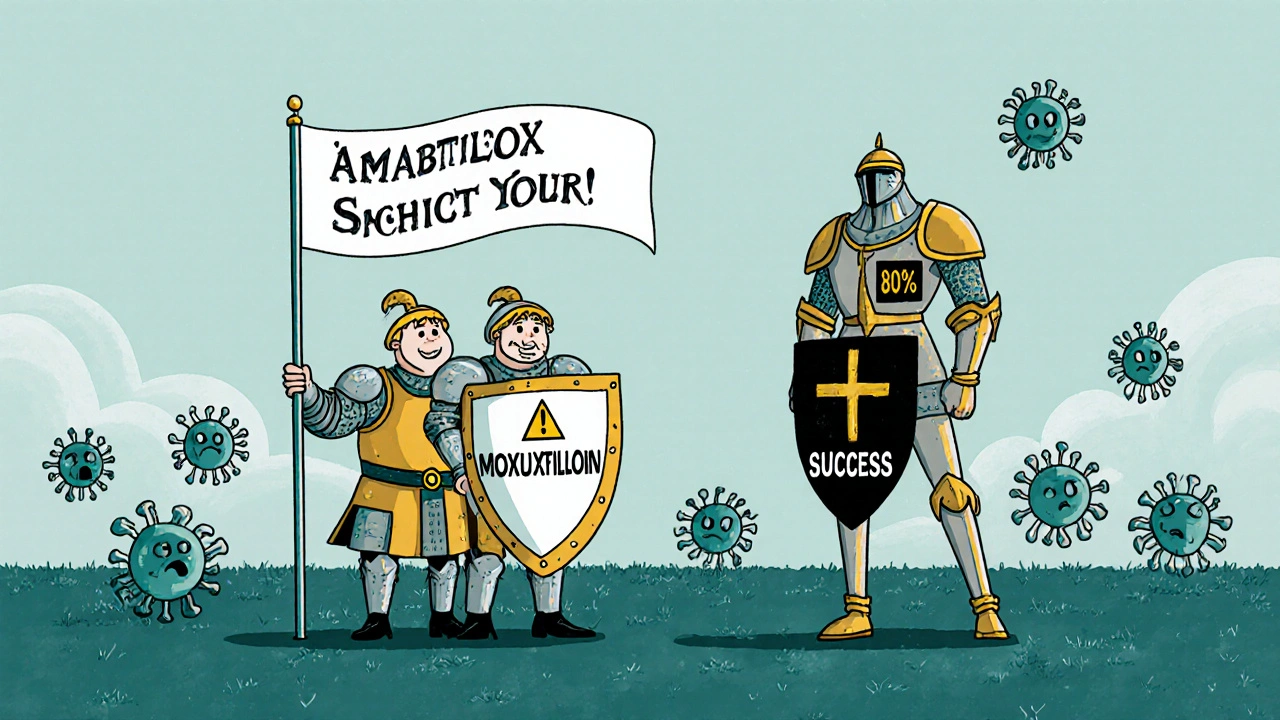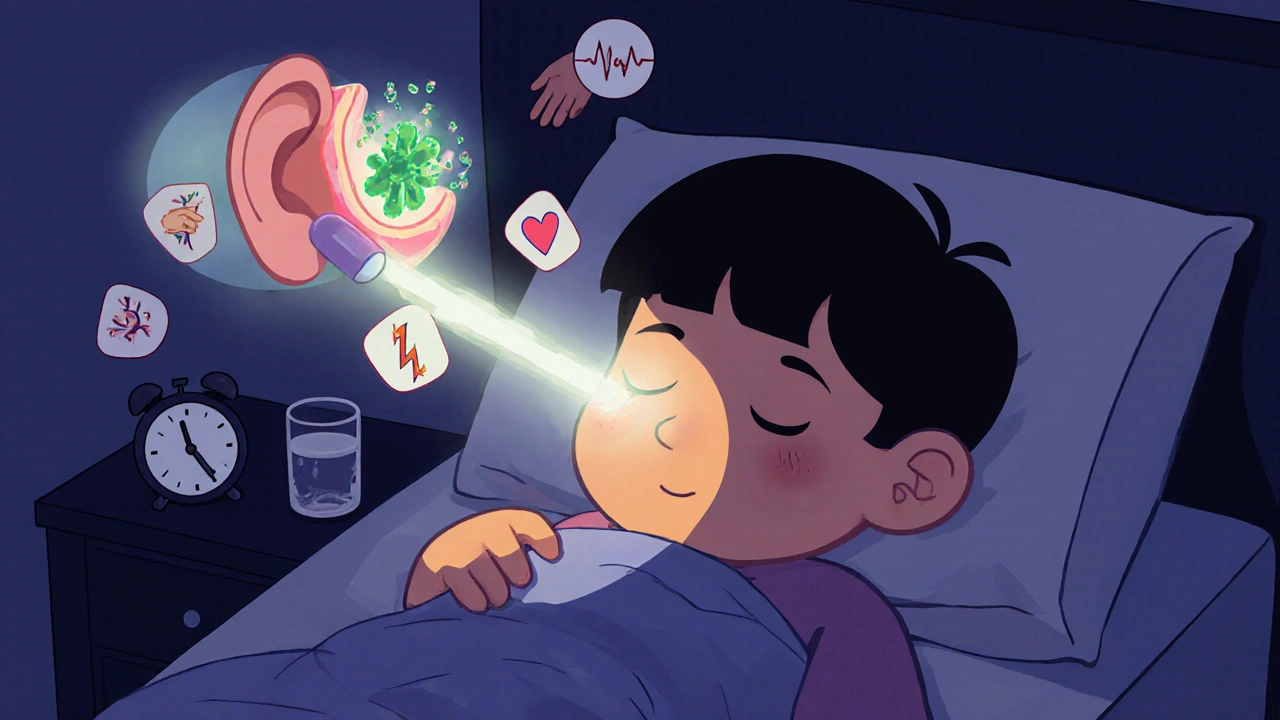Moxifloxacin for Otitis Media: Does It Really Work?
 Nov, 1 2025
Nov, 1 2025
When your child keeps tugging at their ear, or you’re lying awake with a throbbing ache deep inside your ear canal, you don’t want to waste time guessing what works. Otitis media - a middle ear infection - is one of the most common infections in kids, but adults get it too. And when standard antibiotics like amoxicillin don’t clear it up, doctors sometimes turn to moxifloxacin. But is it really the right choice?
What Is Moxifloxacin?
Moxifloxacin is a fluoroquinolone antibiotic that fights bacteria by blocking their ability to reproduce DNA. It’s sold under brand names like Avelox and is used for respiratory, skin, and abdominal infections. But it’s also prescribed off-label for stubborn ear infections when first-line drugs fail.
Unlike amoxicillin, which targets a narrow range of bacteria, moxifloxacin works against a broad spectrum - including strains resistant to other antibiotics. That’s why it shows up in cases where the infection doesn’t improve after 48 to 72 hours of standard treatment. It’s especially useful when Streptococcus pneumoniae, Haemophilus influenzae, or Moraxella catarrhalis are involved - the top three culprits in middle ear infections.
How Otitis Media Works
Otitis media isn’t just a simple earache. It starts when fluid builds up behind the eardrum, often after a cold or allergy. That trapped fluid becomes a breeding ground for bacteria. In kids, the Eustachian tube is shorter and more horizontal, making it easier for germs to travel from the nose to the ear. In adults, it’s often linked to sinus infections or smoking.
Most cases clear up on their own within a week. But if symptoms last longer, get worse, or come with fever, hearing loss, or pus draining from the ear, it’s time to consider antibiotics. The American Academy of Pediatrics recommends amoxicillin as the first choice - it’s cheap, safe, and effective in about 80% of cases.
When Moxifloxacin Is Considered
Doctors don’t reach for moxifloxacin right away. It’s reserved for specific situations:
- Failed treatment with amoxicillin or amoxicillin-clavulanate after 48-72 hours
- Allergy to penicillin or other beta-lactam antibiotics
- Chronic or recurrent otitis media with effusion
- Known or suspected resistant bacterial strains
A 2023 study in the Journal of Pediatric Infectious Diseases followed 187 children with persistent otitis media. Of those who switched to moxifloxacin after failing amoxicillin, 92% showed improvement within five days. That’s a strong signal - but it doesn’t mean it’s the first step.

How It Compares to Other Antibiotics
| Antibiotic | Typical Dose | Effectiveness | Common Side Effects | Best For |
|---|---|---|---|---|
| Amoxicillin | 80-90 mg/kg/day | 80-85% | Diarrhea, rash | First-line, mild to moderate cases |
| Amoxicillin-clavulanate | 90 mg/kg/day | 85-90% | Diarrhea, nausea | Recurrent or severe cases |
| Moxifloxacin | 400 mg once daily | 90-95% | Nausea, dizziness, tendon pain | Resistant infections, penicillin allergy |
| Cefdinir | 14 mg/kg/day | 80-85% | Diarrhea, vomiting | Penicillin allergy, moderate cases |
Moxifloxacin has the highest success rate in the table - but it’s not without risks. Fluoroquinolones like moxifloxacin carry a black box warning from the FDA for tendon rupture, nerve damage, and worsening of myasthenia gravis. These are rare, but they’re serious. That’s why it’s rarely used in children under 18 unless absolutely necessary.
Side Effects and Risks
Most people tolerate moxifloxacin well. The most common complaints are mild: nausea, headache, dizziness, or trouble sleeping. But some side effects can be dangerous.
- Tendon inflammation or rupture - especially in people over 60 or those taking steroids
- Peripheral neuropathy - tingling or numbness in hands and feet that can be permanent
- QT prolongation - a heart rhythm issue that can cause fainting or worse
- Photosensitivity - skin burns easily in sunlight
For adults, these risks are manageable if you’re healthy and follow instructions. For kids, doctors weigh the benefits against the unknown long-term effects. The European Medicines Agency advises against using moxifloxacin in children under 18 for otitis media unless no other options exist.
Dosing and Duration
If your doctor prescribes moxifloxacin for otitis media, you’ll typically get:
- 400 mg once daily, by mouth
- For 5 to 10 days, depending on severity
It’s taken on an empty stomach - at least 4 hours before or 2 hours after antacids, iron, or zinc supplements. Those can block absorption. You can take it with water or milk, but avoid dairy-heavy meals right before or after.
Don’t stop taking it just because your ear feels better. Stopping early is one of the biggest reasons bacteria become resistant. Finish the full course, even if symptoms vanish in two days.

Real-World Use: What Patients Say
On patient forums and pharmacy review sites, reactions to moxifloxacin for ear infections are mixed. Some report dramatic relief within 24 hours. Others say they felt worse before getting better - likely because the antibiotic kills bacteria quickly, triggering an inflammatory response.
One adult from Ohio wrote: “I had three rounds of amoxicillin. Nothing worked. My doctor finally prescribed moxifloxacin. Day two, the pressure dropped. By day four, I could hear again. No more dizziness.”
Another parent from Toronto shared: “My 6-year-old got it after a cold. We tried everything. Moxifloxacin helped, but she was dizzy for three days. We’re not using it again unless it’s life-or-death.”
These stories aren’t outliers. They reflect the reality: moxifloxacin works - but it’s not gentle.
Alternatives and When to See a Specialist
If moxifloxacin isn’t right for you, here are other options:
- High-dose amoxicillin-clavulanate (80-90 mg/kg/day)
- Cefdinir or cefuroxime for penicillin-allergic patients
- Ear drops with antibiotics (if the eardrum has a hole)
- Tympanostomy tubes for recurrent cases
If you’ve had three or more ear infections in six months, or if hearing doesn’t return after treatment, see an ENT specialist. Chronic otitis media can lead to permanent hearing loss or damage to the bones in the middle ear.
Final Thoughts
Moxifloxacin is a powerful tool for stubborn otitis media. It’s not a first-line drug, and it shouldn’t be used casually. But when standard treatments fail, it can be the difference between lingering pain and full recovery.
The key is timing and context. Don’t rush to it. Don’t avoid it when needed. Work with your doctor to understand why it’s being suggested - and what the risks really mean for you or your child.
For most people, a simple course of amoxicillin will do the job. But when it doesn’t? Moxifloxacin might be the answer - if you’re willing to accept the trade-offs.
Is moxifloxacin safe for children with ear infections?
Moxifloxacin is generally not recommended for children under 18 due to potential risks like tendon damage and nerve issues. It’s only used in rare cases where other antibiotics have failed and the infection is severe or caused by resistant bacteria. Always consult a pediatrician or ENT specialist before considering it for a child.
How quickly does moxifloxacin work for ear infections?
Most people notice improvement within 24 to 48 hours. Pain and pressure often drop significantly by day two. However, it’s important to complete the full course - usually 5 to 10 days - even if symptoms disappear sooner. Stopping early increases the risk of the infection coming back or becoming resistant.
Can I take moxifloxacin if I’m allergic to penicillin?
Yes. Moxifloxacin belongs to a completely different class of antibiotics (fluoroquinolones) and does not cross-react with penicillin. It’s a common alternative for people with penicillin allergies. However, always tell your doctor about all your allergies before starting any new medication.
Does moxifloxacin cause dizziness?
Yes, dizziness is a common side effect, especially in the first few days. It’s usually mild and goes away as your body adjusts. Avoid driving or operating heavy machinery until you know how it affects you. If dizziness is severe or lasts more than a few days, contact your doctor.
Can I drink alcohol while taking moxifloxacin?
There’s no direct dangerous interaction between moxifloxacin and alcohol. But alcohol can worsen side effects like dizziness, nausea, and dehydration - which already come with the drug. It’s best to avoid alcohol while on the medication to give your body the best chance to heal.
What should I do if my ear infection doesn’t improve after moxifloxacin?
If symptoms persist after finishing the full course, return to your doctor. The infection may be caused by a virus, fungus, or a resistant strain that needs a different approach. You may need a culture test, imaging, or referral to an ear, nose, and throat specialist. Don’t assume it’s just ‘not working’ - it might need a different strategy.

joe balak
November 2, 2025 AT 09:50Moxifloxacin works but it’s not magic it’s a sledgehammer and we’re using it on a thumbtack
Albert Schueller
November 2, 2025 AT 15:47Did you know the FDA quietly approved fluoroquinolones for ear infections because Big Pharma funded 3 studies with cherry-picked data? They’ve known about the tendon damage since 2008 but kept pushing it because it’s profitable. Your doctor doesn’t care they’re paid by pharma reps. Read the black box warning again. It’s not a side effect it’s a warning label.
Vrinda Bali
November 4, 2025 AT 05:30India has banned moxifloxacin for pediatric otitis media since 2015. The WHO flagged it as a last-resort drug for a reason. Yet here in America we treat antibiotics like candy. My cousin’s daughter developed permanent neuropathy after one course. No one talks about this. The system is broken.
Emily Barfield
November 4, 2025 AT 06:59What does it mean to heal? Is it merely the absence of pain or the restoration of balance? Moxifloxacin silences the bacteria but does it silence the body’s wisdom? We’ve forgotten that inflammation is not the enemy-it’s the messenger. We rush to extinguish the flame without asking why the fire started. Is it better to suppress or to understand? The ear doesn’t lie-it screams when we ignore its truth.
Ryan Tanner
November 6, 2025 AT 01:19Hey if you’ve been through 3 rounds of amoxicillin and still feel like your skull’s about to crack-moxifloxacin saved me. Took 2 days to feel human again. Yeah I was dizzy for a bit but hey I can hear my kid laugh again. Don’t let fear stop you from getting better. 💪🎧
Cornelle Camberos
November 7, 2025 AT 00:03It is imperative to note that the empirical use of moxifloxacin in otitis media constitutes a flagrant disregard for antimicrobial stewardship protocols. The elevated risk of tendon rupture, particularly in individuals over the age of 60, is not a statistical anomaly-it is a clinical catastrophe waiting to be institutionalized. One must question the ethical framework underpinning such off-label prescriptions.
Jessica Adelle
November 8, 2025 AT 06:14As an American citizen who values public health, I find it unconscionable that we allow foreign pharmaceutical corporations to dictate our medical protocols. This drug is banned in Europe for children. Why are we letting them experiment on our kids? We don’t need their toxic shortcuts. We need real medicine-clean, safe, American-made solutions.
Ted Carr
November 8, 2025 AT 06:46So let me get this straight-we have a drug that can rupture your tendons, fry your nerves, and mess with your heart rhythm… but we’re okay using it because your kid’s ear infection didn’t clear up after 72 hours? What’s next? A chainsaw for a splinter? 🤡
Iván Maceda
November 8, 2025 AT 16:53My dad got moxifloxacin after 4 rounds of amoxicillin. He’s 72. He didn’t get tendon damage… but he did get a 3-day migraine and started seeing floating dots. We’re lucky. But I’m not letting my kid near it. 🇺🇸🩺
Sai Ahmed
November 10, 2025 AT 14:35They say it’s for resistant strains. But what if the strain’s resistant because we overused amoxicillin? Who’s to blame? The parents? The doctors? The factory that made the cheap antibiotics? We’re all just pawns. I stopped trusting doctors after my cousin’s kidney failed from a 'routine' antibiotic. Just say no. Let the body heal. 🤷♂️